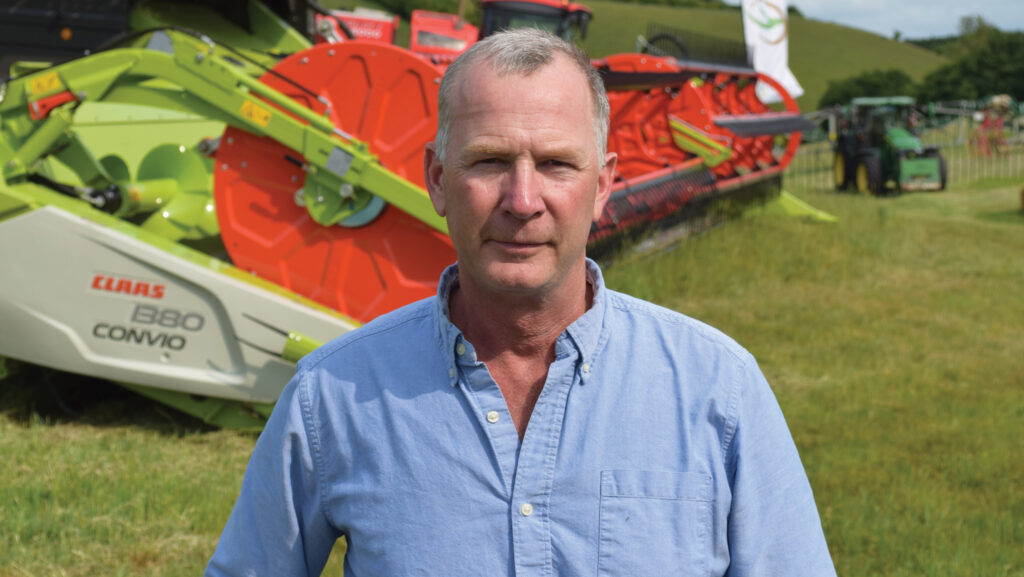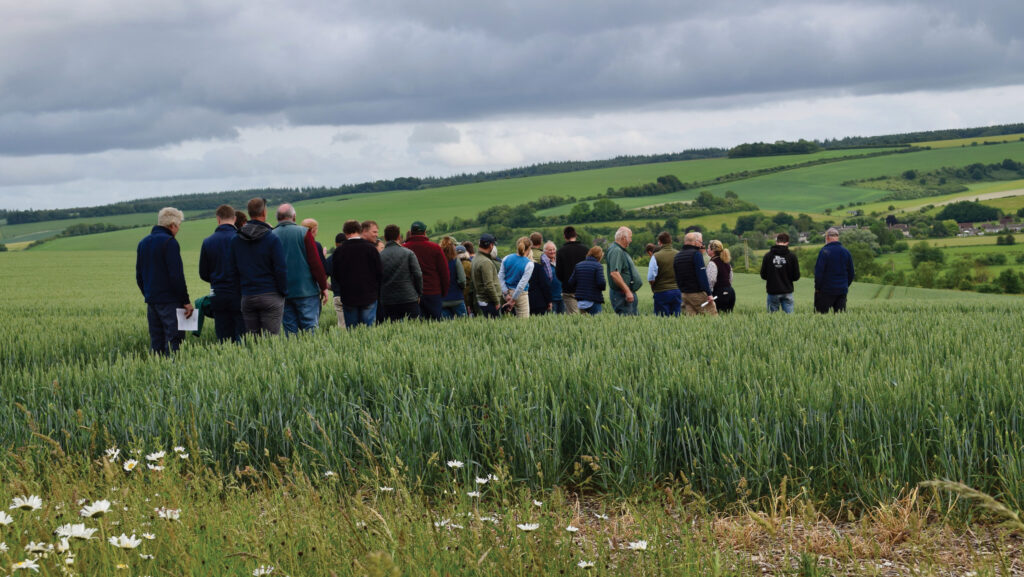How Wilts estate’s ‘practical regen’ approach supports yields
 © Paul Spackman
© Paul Spackman Covering 1,800ha within the Cranbourne Chase National Landscape, a family-owned estate is aiming to increase biodiversity without compromising yields or profits.
The productive chalk downland farm is home to various Red List bird, plant and invertebrate species, and even employs its own full-time ecologist to oversee the ongoing environmental programme.
This includes 100ha of margins and habitats through the Higher Tier Countryside Stewardship scheme, four sites of special scientific interest (SSSIs), a chalk stream rewilding project, hedgerows and various Sustainable Farming Incentive (SFI) options.
Three years ago, the estate also started hosting a large 160ha field-scale trials project in partnership with Farmacy at its Ballington farm, aiming to develop practical and meaningful ways of farming more regeneratively, while maintaining – or improving – yields, output and profitability.
See also: Round-up of the 14 newly recommended winter barleys
“The aim is to improve or replace current practices to secure the future of chalkland farming,” says managing partner, Josh Stratton.
Profitability remains firmly top of the agenda, and he believes this can be achieved alongside greater environmental sustainability, rather than it being a case of one or the other. But doing so requires farmers to think differently and work more closely with supply chains to develop ways of monetising the natural capital on farms, he says.
Farm facts
JM Stratton & Co
- 1,830ha owned land, plus 370ha of local contract farming
- 1,380ha cropped area, all combinable crops, including milling and feed wheat, winter and spring barley, oilseed rape, winter oats, and spring peas
- 8% of the farm is in stewardship
- 230ha of pasture and downland grazed by jointly owned cattle, or a grazier with sheep
- 220ha of amenity woodland
- Co-founded Wylye Valley Farmers cluster group and Environmental Farmers Group natural capital trading co-operative
- Hosts Helix Wiltshire trials in collaboration with Farmacy
“With BPS gone and questions over the future of the SFI and stewardship, we’ve got to be really smart and open to clear thinking about the future. There’s nothing we’re doing here that other growers can’t do on their own farms,” says Josh.
Measuring environmental performance
The partnership with Farmacy will help to clarify which environmental options best suit the farm and, crucially, develop reliable ways of gathering the data needed to benchmark environmental benefits against which improvements can be measured – and potentially monetised in future.
“Unless we can measure what we’re doing and establish a baseline of environmental performance, it’s very hard to judge any improvements being made,” says Farmacy development manager, Jennie Watson.
“We have a unique opportunity to try out new farming practices and technology on a field scale. There’s a lot of technology to support alternative ways of working and help make businesses more profitable, but we need to make sure it’s fit for purpose first.”
That measuring takes various forms, including comprehensive soil analysis, Terramap high-resolution mapping, regular tissue and sap testing, bird and insect monitoring, and digital systems that can assess pollinator populations by capturing their sound waves. Omnia is being used to capture, store and analyse much of this data, and help inform management decisions across the farm and trials area.
Building biodiversity
Traditionally, much of the environmental focus at Stratton Farms has been on building biodiversity around field edges, utilising stewardship options, and natural assets, including hedgerows, floristically enhanced margins, woodland, chalk downland, and the 50ha of winter bird food and nectar plots established across the farm.
“We have noticed a significant boost to wild bird, butterfly, and small mammal populations during the life of these schemes,” says Josh.

Josh Stratton © Paul Spackman
Since 2012 there has also been a concerted focus on improving soil health, involving the introduction of a controlled traffic farming system of permanent tramlines, and direct drilling across the farm, although some shallow cultivations are still used where necessary.
Overwinter cover crops are also utilised for a range of soil health benefits, including building organic matter, feeding soil biology, improving structure, sequestering carbon, and reducing leaching/erosion losses over winter to improve water quality. Much of the straw is chopped rather than baled to further add carbon, organic matter and nutrients back to the soil.
“We are seeing consistent yields, so our year-to-year movement is negligible as a result of resilient soils. Overall, there’s been a 10-15% yield increase over 10 years,” notes Josh.
In-field biodiversity

© Paul Spackman
The focus now is on finding ways to further improve biodiversity within commercial arable fields, without compromising productivity – something the partnership with Farmacy is investigating.
Field trials cover a range of options, and their long-term impact across the rotation, focusing on soil health, plant resilience, biodiversity, fertiliser reduction and carbon efficiency, including:
- Supporting soil biology with organic matter additions (baled vs chopped straw trial in oilseed rape (OSR)), use of digestate, and cover crops
- Using wheat blends within the disease management programme
- Companion crops (such as winter oats and beans, winter wheat and vetch) and bi-cropping (such as winter oats and beans, winter wheat and beans, spring barley with peas and beans) to support more in-field biodiversity and bring a diversity of crop rooting and exudates to support different soil bacteria
- Long-term use of a clover understory through the rotation
- Utilising new barley yellow dwarf virus-resistant winter wheat to avoid insecticide use
- Investigate the impact of using digestate to offset synthetic fertiliser requirements
- Test novel products to improve nitrogen use efficiency and reduce reliance on artificial N to minimise its impact on soil biology
- Long-term nutrition trials in winter barley and OSR.
Trials are ongoing, but Josh and Farmacy want other farmers to learn from the work, so plan to host a results meeting to discuss latest findings in the autumn.
Is digestate changing the soil microbiome?

© Farmacy
Supporting and enhancing soil biology is one key route to building in-field biodiversity, and to do that, growers need to provide sufficient food sources year-round, says head of soils, Ian Robertson.
That can be any growing plant that captures sunlight and “feeds” biology with sugars, amino acids and organic acids, as exudates. Organic matter additions, such as crop residues, manures, or digestate, are also important sources.
“The beautiful thing about digestate is it’s digested material, so you’re putting a complete nutritional product into the soil to feed a really good microbiome.”
For the past decade, the farm has been applying PAS110 accredited digestate from a 3.6 MW food waste anaerobic digester plant set up as a joint venture in 2014. This provides organic matter and key nutrients to crops (notably nitrogen, phosphate and potassium), reducing synthetic fertiliser use by 70-80%.
Most digestate is applied via a network of lagoons, pipes and umbilical system to minimise soil damage, although a self-propelled tanker is used on more inaccessible areas.
Trials
To better understand the impact of digestate use on crop profitability and soil biology, two split-field trials are comparing digestate versus synthetic bagged fertiliser, revealing interesting differences in nutrient uptake.
“Because some nutrients are digested already, we’ve seen in the past two seasons digestate-treated crops looking darker, greener and better, yet there was no difference in yield. Chloride in digestate is known to turn plants green, while tissue and sap testing shows quite a mineral imbalance in these plants,” says Ian.
Digestate is high in readily available nitrogen, which plants take in through mass flow, and in doing so, other elements also taken in by mass flow, such as magnesium, are being “bullied out”, he explains. “So, plants can look really green, but aren’t photosynthesising properly.”
Nutrient uptake changes
This change in plant nutrient uptake is likely to alter the exudates pumped back into the soil to feed the soil food web, he adds. “Some 45-60% of energy captured is pushed into the soil. If there’s an imbalance in that energy going into soil, it will feed an imbalanced microbiome.
“If we know this is happening, we can look at ways to rectify it. For example, if plants need magnesium, we can easily apply that when the crop needs it to maximise the value of the digestate.”
Ian says they may also find that instead of relying on digestate, they are better off using both digestate and urea/ammonium nitrate, which has a slower release of nitrogen to the plant.
“Farmers may not get paid directly for soil health, but if you’ve got a healthy, functional, soil, it will be working better for you, and utilising your resources better.”
Avoid rash decisions
Government stewardship schemes have driven many of the environmental measures implemented on farms, but with uncertainty over future funding, Hutchinsons farm business consultant Leo Page worries some areas could end up being brought back into production when schemes end.
“Before making any sudden decisions at the end of an agri-environment scheme, really think about the alternative approaches you can take to make the most of the natural capital that has been built up.
“Those areas are all habitats, that have been slowly building up a value. If we plough that up when schemes end, that capital value is lost. We need to look at how we can fund this natural capital in a different way, through non-governmental schemes, such as Wildfarmed, water companies, or Soil Association Exchange, for example.”

